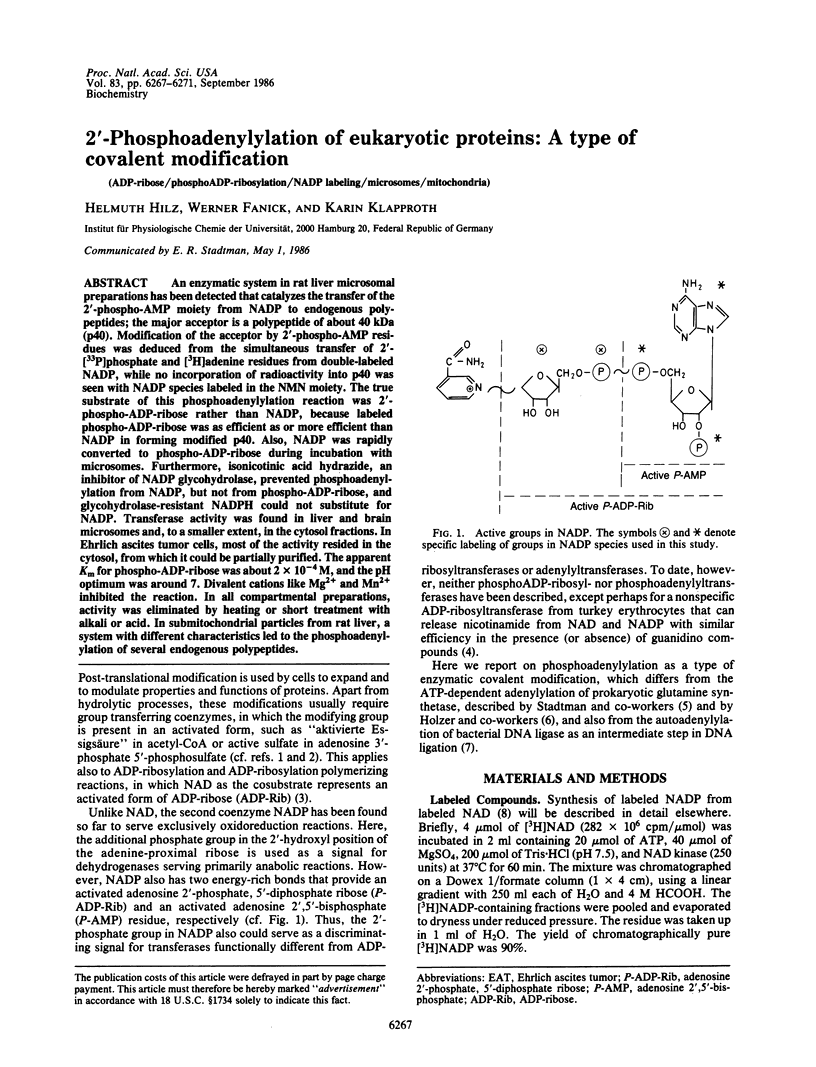Abstract
An enzymatic system in rat liver microsomal preparations has been detected that catalyzes the transfer of the 2'-phospho-AMP moiety from NADP to endogenous polypeptides; the major acceptor is a polypeptide of about 40 kDa (p40). Modification of the acceptor by 2'-phospho-AMP residues was deduced from the simultaneous transfer of 2'-[33P]phosphate and [3H]adenine residues from double-labeled NADP, while no incorporation of radioactivity into p40 was seen with NADP species labeled in the NMN moiety. The true substrate of this phosphoadenylylation reaction was 2'-phospho-ADP-ribose rather than NADP, because labeled phospho-ADP-ribose was as efficient as or more efficient than NADP in forming modified p40. Also, NADP was rapidly converted to phospho-ADP-ribose during incubation with microsomes. Furthermore, isonicotinic acid hydrazide, an inhibitor of NADP glycohydrolase, prevented phosphoadenylylation from NADP, but not from phospho-ADP-ribose, and glycohydrolase-resistant NADPH could not substitute for NADP. Transferase activity was found in liver and brain microsomes and, to a smaller extent, in the cytosol fractions. In Ehrlich ascites tumor cells, most of the activity resided in the cytosol, from which it could be partially purified. The apparent Km for phospho-ADP-ribose was about 2 X 10(-4) M, and the pH optimum was around 7. Divalent cations like Mg2+ and Mn2+ inhibited the reaction. In all compartmental preparations, activity was eliminated by heating or short treatment with alkali or acid. In submitochondrial particles from rat liver, a system with different characteristics led to the phosphoadenylylation of several endogenous polypeptides.
Full text
PDF




Images in this article
Selected References
These references are in PubMed. This may not be the complete list of references from this article.
- Adamietz P., Wielckens K., Bredehorst R., Lengyel H., Hilz H. Subcellular distribution of mono(ADP-ribose) protein conjugates in rat liver. Biochem Biophys Res Commun. 1981 Jul 16;101(1):96–103. doi: 10.1016/s0006-291x(81)80015-0. [DOI] [PubMed] [Google Scholar]
- Bordier C. Phase separation of integral membrane proteins in Triton X-114 solution. J Biol Chem. 1981 Feb 25;256(4):1604–1607. [PubMed] [Google Scholar]
- Hilz H., Koch R., Fanick W., Klapproth K., Adamietz P. Nonenzymic ADP-ribosylation of specific mitochondrial polypeptides. Proc Natl Acad Sci U S A. 1984 Jul;81(13):3929–3933. doi: 10.1073/pnas.81.13.3929. [DOI] [PMC free article] [PubMed] [Google Scholar]
- Hilz H., Lipmann F. THE ENZYMATIC ACTIVATION OF SULFATE. Proc Natl Acad Sci U S A. 1955 Nov 15;41(11):880–890. doi: 10.1073/pnas.41.11.880. [DOI] [PMC free article] [PubMed] [Google Scholar]
- Hilz H., Stone P. Poly(ADP-ribose) and ADP-ribosylation of proteins. Rev Physiol Biochem Pharmacol. 1976;76:1-58, 177. doi: 10.1007/BFb0027686. [DOI] [PubMed] [Google Scholar]
- Kun E., Kirsten E., Piper W. N. Stabilization of mitochondrial functions with digitonin. Methods Enzymol. 1979;55:115–118. doi: 10.1016/0076-6879(79)55016-2. [DOI] [PubMed] [Google Scholar]
- Laemmli U. K. Cleavage of structural proteins during the assembly of the head of bacteriophage T4. Nature. 1970 Aug 15;227(5259):680–685. doi: 10.1038/227680a0. [DOI] [PubMed] [Google Scholar]
- Lehman I. R. DNA ligase: structure, mechanism, and function. Science. 1974 Nov 29;186(4166):790–797. doi: 10.1126/science.186.4166.790. [DOI] [PubMed] [Google Scholar]
- McCreanor G. M., Bender D. A. The role of catabolism in controlling tissue concentrations of nicotinamide nucleotide coenzymes. Biochim Biophys Acta. 1983 Sep 13;759(3):222–228. doi: 10.1016/0304-4165(83)90316-1. [DOI] [PubMed] [Google Scholar]
- Nolde S., Hilz H. Extracellular NAD as a cytostatic agent. Hoppe Seylers Z Physiol Chem. 1972 Apr;353(4):505–513. doi: 10.1515/bchm2.1972.353.1.505. [DOI] [PubMed] [Google Scholar]
- Shapiro B. M., Kingdon H. S., Stadtman E. R. Regulation of glutamine synthetase. VII. Adenylyl glutamine synthetase: a new form of the enzyme with altered regulatory and kinetic properties. Proc Natl Acad Sci U S A. 1967 Aug;58(2):642–649. doi: 10.1073/pnas.58.2.642. [DOI] [PMC free article] [PubMed] [Google Scholar]
- Skala H., Vibert M., Kahn A., Dreyfus J. C. Phospho ADP ribosylation of human glucose 6 phosphate dehydrogenase: probable mechanism of the occurrence of hyperanodic forms. Biochem Biophys Res Commun. 1979 Aug 13;89(3):988–996. doi: 10.1016/0006-291x(79)91875-8. [DOI] [PubMed] [Google Scholar]
- Wulff K., Mecke D., Holzer H. Mechanism of the enzymatic inactivation of glutamine synthetase from E. coli. Biochem Biophys Res Commun. 1967 Sep 7;28(5):740–745. doi: 10.1016/0006-291x(67)90378-6. [DOI] [PubMed] [Google Scholar]
- ZATMAN L. J., KAPLAN N. O., COLOWICK S. P. Inhibition of spleen diphosphopyridine nucleotidase by nicotinamide, an exchange reaction. J Biol Chem. 1953 Jan;200(1):197–212. [PubMed] [Google Scholar]




